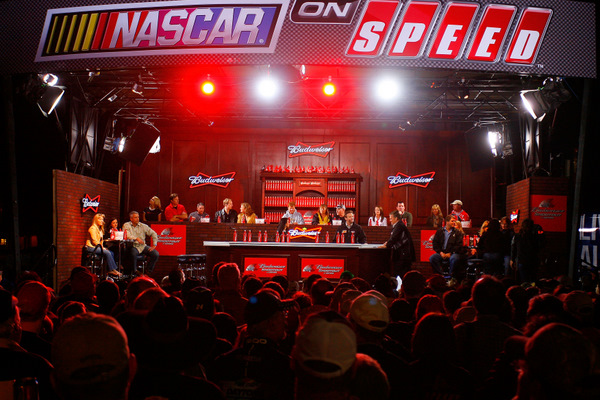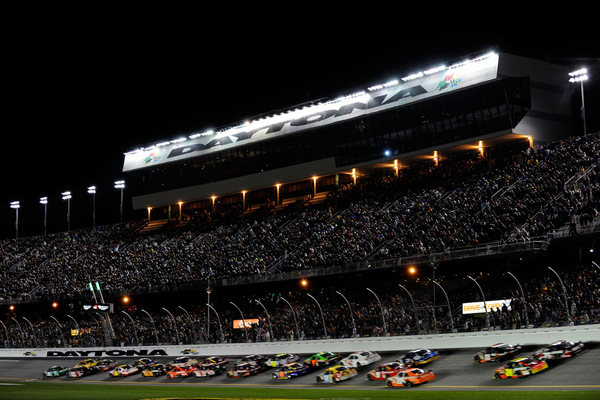Daytona opens the doors for Media Day...and just who is the NASCAR media these days?

New Speed TV boss Patti Wheeler says this isn't your father's NASCAR TV stuff any more, and she plans to light things up. Okay, let's see what she's got (Photo: Getty Images for NASCAR)
By Mike Mulhern
mikemulhern.net
And after the NFL's record-smashing Super Bowl, NASCAR-on-TV better be hot for SpeedWeeks and ready to rock 'n roll.
Fox' Super Bowl, with its 111 million viewers, certainly set the bar high. That's the biggest TV audience in history.
So cue the Fox guys here handling the Daytona 500. They've certainly got their work cut out.
One good thing for NASCAR – the competition out on the track has been superb lately, and the new asphalt here should only intensify that.
And the electronic cheerleaders are expected to be out in force here, starting with Thursday's Daytona Media Day marathon.
However……
Among the sidelights to consider here during SpeedWeeks – not only the crowds, and the television audiences, but also which major American newspapers show up to cover things (since only one U.S. daily still dutifully covers the full NASCAR tour, which runs now till November).
The state of American mass media, particularly the NASCAR mass media, is somewhat unclear at the moment, and not just demographically. To recall what Sundance once famously asked Butch: "Who are those guys?"
And how to crank up enthusiasm among the hotly courted 18-34 male demographic?
Why have so many NASCAR fans turned simply apathetic?
How to cure the malaise?
Something's going on.
Maybe a little Milka Duno can help fix some things….the Indy racer is in Saturday's ARCA 200.
Maybe Rick Hendrick or Jack Roush ought to do a NASCAR IPO, and see what a little Wall Street action might do? Wouldn't you watch more races if you really had some skin in this game?
That media is changing isn't new.
But have Twitter and Facebook essentially replaced the venerable daily newspaper and local TV?
That's not all to consider:
-- Murdoch plans to launch The Daily, a web-only subscription paper.
-- AOL, for example, was once a headline web operation, but now it's fading fast, and that $315 million purchase of the Huffington Post is curious; AOL just dropped its own NASCAR coverage and will be buying outsourced racing coverage now.
-- Just how important NASCAR's Nationwide series might be in the grand scheme of things may be up for debate, with ESPN's decision to drop the Richmond April race in order to carry the NBA playoffs. ESPN's February to November Nationwide coverage has been considered one of this sport's anchors.
-- But it's the newest player on the block that could be, eventually, a big player in NASCAR, one way or the other – cable giant Comcast, with its recent purchase of NBC. ABC-ESPN and Fox-Speed could be finding major sports competition from Comcast, depending on what Comcast executives decide.
But that's big-picture stuff. Down here in the trenches the two big SpeedWeeks stories are asphalt and Earnhardt.
A year ago the NASCAR season got off to a rocky start, with the Pothole 500, where Bondo – that amazing plasticized putty – finally saved the season opener, after several attempts at asphalt repairs over some two hours failed.
This time, of course, there's brand new asphalt, more than $20 million worth.
(And Daytona may not be the only track with new asphalt this year. Phoenix International Raceway is expected not only to be repaved but perhaps even slightly redesigned, after the Feb. 27th race.)
First up: media memorials to the late Dale Earnhardt, whose death here precisely 10 years ago, on the last lap of the Daytona 500, triggered a sports tsunami across America and led to wide-ranging safety improvements in NASCAR racing.
And the various networks are throwing everything at us, in dissecting Earnhardt's death.
Just imagine the pressure Dale Earnhardt Jr. will be under this SpeedWeeks, which kicks off with Saturday night's Bud Shootout.
Some may say The Big E is 10 years dead now, and it's time to let him rest in peace.
Later, however.
No, Feb. 18th isn't a national holiday, but it will be the focal point for all this. That's the Friday before the Feb. 20th Daytona 500.
And the TV marathon begins with a one-hour Speed special Feb. 11th.
Speed TV may be one of the changes to keep an eye on this season.
Speed is now run by Patti Wheeler, the veteran TV producer who has been given a free hand by Fox boss David Hill to spice up its NASCAR coverage. The past several years TV in general has been rather namby-pamby about a lot of NASCAR issues. Wheeler is vowing to change all that.
It will be interesting to see how these TV specials handle the various safety issues surrounding Earnhardt's death, and the three deaths a season earlier, Adam Petty and Kenny Irwin at Loudon, NH, and Tony Roper at Texas.
One issue at that time was why it took four deaths before NASCAR made such a concerted push toward improving safety.
In the years since, however, there has been little debate about NASCAR's vigor in addressing safety issues whenever it encountered them.
Since Earnhardt's death serious injuries in NASCAR have been rare.
However safety, even now, years later, still has aspects to review – such as Jeff Gordon showed during that odd crash at Las Vegas…and as Elliott Sadler showed last summer at Pocono.
Soft walls – the Safer Barrier – have been one big safety improvement, saving maybe half a dozen or more NASCAR drivers who would perhaps have died in violent crashes.
And the Hans isn't the only in-car safety item that has made such a difference. The entire driver cockpit area has been redesign, with markedly better seats and head rests. G-force black boxes provide NASCAR engineers with a lot of crash data. NASCAR, though it still doesn't have a traveling medical staff as other racing series do, has upgraded its medical operations in general and has medical nurses
In the car-of-tomorrow, numerous safety issues have been added, such as a taller roof, for more driver-head clearance (an issue for tall drivers like Michael Waltrip), and moving the driver away from the door toward the center of the car.
Following Earnhardt's death, NASCAR's R&D center in Concord, N.C., became a focal point for numerous safety studies.
One big question still: if Dale Earnhardt had been wearing a Hans device – that special head and neck safety restraint – would he still be alive today?
Jim Downing, the Hans man, is wary of the question: "We have learned over the years…that reconstructing accidents is an extremely difficult and complex chore.
"We rely on the professional experience of others. And in this case there were different opinions by experts about the cause of the fatal injuries.
"With that in mind, I believe that when Dale Earnhardt Sr.'s car hit the wall, and the belts from his safety harness were loaded by the impact, that a HANS Device would have kept his head back.
"That likely would have produced a better outcome under the different scenarios that have been proposed by experts.
"This is what it seems like to me…but we don't really know for sure."
The Hans device is but one major safety plus to come out of Earnhardt's death. It had been used, by a few drivers, for years. But Earnhardt's death and the NASCAR inquiry, and subsequent rules changes mandating the Hans, put the device – which is designed to keep the head from jerking forward during a crash and causing injuries such basil skull fractures – center stage.
"We went from selling 250 in 10 years to selling 250 in one week," Downing says.
Over the 2001 season some 3,000 Hans devices were sold.
The reaction to Earnhardt's death, in many respects, mirrored the 1994 death of Formula One star Ayrton Senna – in headline impact and in safety advances.
"The Senna crash started a really serious re-evaluation of safety in Formula 1," Downing says, "much as what happened later in American racing in 2001.
"This crash led to cooperation with Daimler-Benz to get the Hans device to fit into an F1 car, and more independent testing, which also confirmed it worked.
"Through that development, we were able to reduce the size of the Hans and get a better fit for drivers in all types of cars, including stock cars."
And Downing says of Earnhardt "when I think of Dale Earnhardt Sr., I think of safety, instead of the macho-driving style he was known for."
Speed kills? Not necessarily, as the intense NASCAR investigation showed. In fact Earnhardt's crash was actually at effectively less than 45 mph, studying the physics of it.
And that might have been only one of the surprises to come out of the investigation.
"To many observers it looked like a fairly routine wreck," Downing said.
"A car's speed may not be very high…but if it stops suddenly, you can be in real trouble.
"It’s not how fast you go, but how quickly you stop."
Unfortunately Downing says "Trying to get that message across to short-track racers and drag racers has been especially difficult.
"Both circle-track and drag racing are relatively underserved when it comes to frontal head restraints."

The Shootout this year will be on new Daytona asphalt, and drivers aren't sure quite what to expect (Photo: Getty Images for NASCAR)
© 2010-2011 www.mikemulhern.net All rights reserved.
Web site by www.webdesigncarolinas.com







I hope Patti does wonders at
I hope Patti does wonders at Speed, if NASCAR doesn't whoa her back for getting to intense or subjective to/on NASCAR racing. Let's not forget about Blaise Alexander, who died at Charlotte later that 2001 year in an ARCA race, ironically with another Earnhardt, Kerry Earnhardt during the final laps of that race. He opted out of using a Hans device and unfortunately it may have cost him his life.
Post new comment